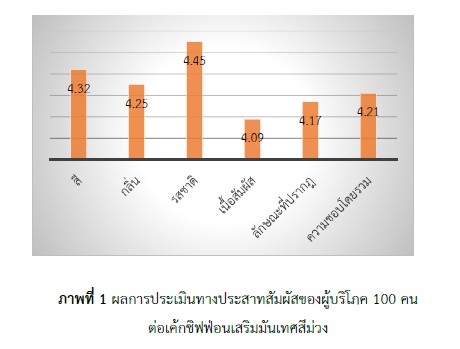Product Development of Purple Sweet Potato Chiffon Cake
Main Article Content
Abstract
The objective of this research was to establish the most suitable amount of purple sweet potato to improve the quality of chiffon cake, considering both its chemical composition and sensory properties. An examination was conducted on four varying levels of purple sweet potato enrichment (0%, 80%, 100%, and 120% in relation to the weight of flour). The study revealed that the optimal quantity of purple sweet potato for producing purple sweet potato chiffon cake significantly influenced sensory quality attributes (p≤0.05). Participants showed the highest acceptance of the formulation enriched with 100% purple sweet potato. The mean scores for sensory characteristics such as color, flavor, taste, texture, appearance, and general liking were determined to be 8.62, 8.72, 8.78, 8.58, 8.55, and 8.57, respectively. There were big differences (p≤0.05) in the chemical quality of the four levels of purple sweet potato enrichment when it came to ash, moisture content, and water activity (aw). Notably, the formulation enriched with 100% purple sweet potato exhibited ash, moisture content, and water activity values of 2.10, 39.43, and 0.78, respectively. In term of physical characteristics, statistical analysis revealed significant differences (p≤0.05) in the L* a* and b* color values among the four levels of purple sweet potato enrichment. Specifically, the formulation enriched with 100% purple sweet potato displayed L* a* and b* color values of 62.86, 7.52, and 10.68, respectively. A panel of 100 consumers rated the sensory attributes of the formulation enriched with 100% purple sweet potato, indicating the highest level of consumer acceptance.
Article Details
References
กรรณิการ์ กุลยะณี และพนารัตน์ สังข์อินทร์. (2562). ผลของกัวร์กัมต่อคุณภาพของวาฟเฟิลชนิดกรอบปราศจากกลูเตนจากแป้งมันเทศสีม่วง. วารสารวิทยาลัยดุสิตธานี, 13(1), 315-329.
งามทิพย์ ภู่วโรดม. (2538). ก๊าชกับการบรรจุผลิตภัณฑ์อาหาร. (พิมพ์ครั้งที่ 2). โรงพิมพ์ลินคอร์นโปรโมชั่น.
นรินทร์ เจริญพันธ์. (2561). การพัฒนาผลิตภัณฑ์คุกกี้จากมันเทศ. วารสารเทคโนโลยีการอาหาร มหาวิทยาลัยสยาม, 13(2), 32-43.
นวพร หงส์พันธุ์, กัญญารัตน์ ไชยณรงค์ และสุนทรียา กาละวงศ์. (2564). การศึกษาระดับการทดแทนแป้งสาลีบางส่วนด้วยพิวรีมันเทศสีม่วงต่อคุณภาพของผลิตภัณฑ์บราวนี่. วารสารวิทยาศาสตร์บูรพา, 26(3), 1745-1761.
นิภาพร กุลณา, กรวุฒิ มงคล, ปานสิน แก้วบุญเรือง, ณัฐพร สุยะวาณิชย์ และปรานปรียา สิทธิ์ขันแก้ว. (2564). ผลของการเสริมเส้นใยอาหารจากผงเปลือกมังคุดต่อคุณภาพทางประสาทสัมผัสของชิฟฟ่อนเค้กน้ำมังคุด. วารสารวิจัยและนวัตกรรมการอาชีวศึกษา, 5(1), 53-61.
บุญยนุช ภู่ระหงษ์, ณนนท์ แดงสังวาลย์, ธัญญาเรศ ดาวพิเศษ และอณัญญา เกาฏีระ. (2566). การใช้ถั่วทองทดแทนอัลมอนด์ในมาการอง. วารสารคหกรรมศาสตร์และวัฒนธรรมอย่างยั่งยืน, 5(1), 59-73.
พนารัตน์ สังข์อินทร์ และกิ่งกาญจน์ ป้องทอง. (2565). การทดแทนแป้งสาลีด้วยแป้งมันเทศส้มในขนมปัง. Naresuan Phayao Journal, 15(3), 96-110.
พรชัย พุทธรักษ์, ปานรวี คีรีรักษ์, ชลิดา ราวสกุล, อลิษา ไชยรัตน์ และกษิเดช ฉันทกุล. (2566). ทัศนคติและพฤติกรรมการบริโภคขนมไทยของนักศึกษามหาวิทยาลัยราชภัฏสงขลา. วารสารคหกรรมศาสตร์และวัฒนธรรมอย่างยั่งยืน, 5(2), 1-12.
ไพโรจน์ วิริยจารี. (2545). การประเมินทางประสาทสัมผัส (Sensory Evaluation) (พิมพ์ครั้งที่ 2). มหาวิทยาลัยเชียงใหม่.
ภัทราภรณ์ สุขขาว, พวงเพ็ชร์ นิธยานนท์ และอนันต์ บุญปาน. (2566). การพัฒนาผลิตภัณฑ์บิสกิตเพื่อสุขภาพจากมันเทศสีม่วงที่มีค่าสตาร์ชทนย่อยสูง. วารสารเทคโนโลยีการอาหาร มหาวิทยาลัยสยาม, 18(1), 21-38.
โรงเรียนสอนทำขนมอบและอาหาร ยูเอฟเอ็ม. (ม.ป.ป.). หลักสูตรขนมอบ. โรงเรียนสอนทำขนมอบและอาหาร ยูเอฟเอ็ม.
ละอองศรี ศิริเกษร, สุชาดา บุญเลิศนิรันดร์ และวชิรญา เหลียวตระกูล. (2561). การเปรียบเทียบการเจริญเติบโตและผลผลิตของมันเทศ 6 พันธุ์. วารสารวิจัยมหาวิทยาลัยเทคโนโลยีราชมงคลศรีวิชัย, 10(3), 411-423.
ศิริวรรณ อรรถสุวรรณ. (2566, 3 พฤษภาคม). มูลค่าตลาด ‘ขนมอบ’ ปีนี้ 4.4 หมื่นลบ. ‘ฟาร์มเฮาส์’ 1 ใน 4 แบรนด์ดัง ครองส่วนแบ่งสูงถึง 20.5%. https://thebusinessplus.com/Bakery/
สุชญา อาภาภัทร. (2559). ปัจจัยที่มีอิทธิพลต่อการตัดสินใจซื้อเบเกอรีแบบ Take Away ของกลุ่มคนทำงานในเขตกรุงเทพมหานครและปริมณฑล. [การค้นคว้าอิสระมหาบัณฑิต]มหาวิทยาลัยธรรมศาสตร์.
สุพิชญา คำคม. (2563). ผลของการทดแทนแป้งสาลีบางส่วนด้วยแป้งมันเทศสีม่วงต่อสมบัติทางเคมีกายภาพ และกิจกรรมการต้านออกซิเดชันของผลิตภัณฑ์หมั่นโถว. วารสารวิทยาศาสตร์บูรพา, 25(2), 664-679.
หทัยชนก ลี้ปฐมากุล และสุพิชญา คำคม. (2562). ผลของการทดแทนแป้งสาลีบางส่วนด้วยแป้งมันเทศสีม่วงต่อลักษณะทางกายภาพ คุณค่าทางโภชนาการ และทางด้านประสาทสัมผัสของเอแคลร์. วารสารวิจัยและพัฒนา วไลยอลงกรณ์ ในพระบรมราชูปถัมภ์ สาขาวิทยาศาสตร์และเทคโนโลยี, 14(3), 72-85.
Ooraikul, B. and Stiles, M.E. (1991). Modified Atmosphere Packaging of Foods. England. Ellis Horwood.
Panda, V. and Sonkamble, M. (2012). Phytochemical constituents and Pharmacologicalactivities of Ipomoeabatatas L. (Lam) -A review. International Journal of Researchin Phytochemistry and Pharmacology, 2(1), 25-34.
Punfujinda, C., Pattarathitiwat, P., Songpranam, P., Chitravimol, U., Buranasuont, R. and Chumkaew, K. (2021). Product Development of Sweet Fish Sauce from Dried White Shrimp: Sensory Evaluation, Physical and Chemical Quality and Nutrition. Journal of Food Health and Bioenvironmental Science, 14(3), 42-51.
Ramírez-Maganda, J., Blancas-Benítez, F.J., Zamora-Gasga, V.M., García-Magaña, M.D.L., Bello-Perez, L.A., Tovar, J. and Sáyago-Ayerdi, S.G. (2015). Nutritional Properties and Phenolic Content of a Bakery Product Substituted with a Mango (Mangifera indica) ‘Ataulfo’processing by-product. Food Research International, 73, 117-123.
Selvakumaran. L., Shukri. R., Ramli. N.S., Pak Dek M.S. and Wan Ibadullah, W. Z. (2019). Orange sweet potato (Ipomoea batatas) puree improved physicochemical properties and sensory acceptance of brownies. Journal of the Saudi Society of Agricultural Sciences, 18, 332-336.
Tian, J., Chen, J., Lv, F., Chen, S., Chen, J., Liu, D. and Ye, X. (2016). Domestic cooking methods affect the phytochemical composition and antioxidant activity of purple-fleshed potatoes. Food Chemistry, 197, 1, 264–1,270.

